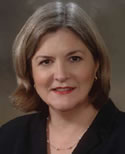Editor's Note: You may have noticed that in the last year or so we have been reserving space on this page to spotlight leading American hematologists of yesteryear and past and present ASH Scholar Award winners. With this issue, we are expanding the scope of the types of individuals we will be highlighting. We are broadening this series to include individuals who are currently in high-profile positions, such as hematologists who are members of the National Academy of Sciences or Institute of Medicine or who hold major national or international leadership positions.
I went to Yale College in 1980, hoping to become a scientist. I was fortunate to encounter Joan Steitz, then a young professor at the forefront of molecular biology. Joan’s lab was a bold and exciting place. I was there to witness the discovery of snurps — ribonucleoprotein particles that are now known to play several fundamental roles in cell biology. Snurps were revealed by using sera from patients with autoimmune disorders to immunoprecipitate autoantigens from cell lysates. It was a serendipitous and smart approach that taught me how major advances could come from looking at human disease in a novel way — a lesson that has served me well.
I probably would not have gone to medical school if it weren’t for the MD-PhD students who orbited around Joan’s lab. I ended up in the MD-PhD program at Harvard and did my PhD thesis work with Nobel laureate David Baltimore at MIT. There was a strong hematology presence at MIT at that time. Both Sam Lux and David Nathan passed through on sabbaticals, working with Harvey Lodish, David Housman, and others. The MIT Biology Department proved to be a remarkable incubator for scientific talent in the early 1980s. An astounding number of current scientific leaders spent time there as students, postdocs, or visiting scientists. I was in the Baltimore lab when the Whitehead Institute was born, with David as its founding director. It was fun to watch — and it probably inspired my own foray into administration two decades later.
I formally entered hematology in 1989 as a fellow at Children’s Hospital Boston and Dana-Farber Cancer Institute. Although I enjoyed taking care of patients and did clinical work for many years, my primary focus was on research. I was interested in red cells and chose Stuart Orkin’s lab for my fellowship research. There I took advantage of my previous biochemistry experience to purify and clone a hematopoietic-specific transcription factor, NF-E2. It was a demanding job, requiring thousands of liters of cultured cells to get enough material, but it worked in the end.
I might have continued working on NF-E2 if it weren’t for several circumstances that lured me into iron biology, two of which were mentoring a medical student, Mark Fleming, and becoming an investigator of the Howard Hughes Medical Institute (HHMI). Mark, now a long-time collaborator, convinced me to share his curiosity about the pathophysiology of hemochromatosis. HHMI provided the unrestricted funding I needed to move into a completely new area of science.
Iron biology has been a very exciting field in which to grow my career. Together with outstanding colleagues from around the world, I’ve contributed to an explosion of knowledge about mammalian iron homeostasis and human iron disorders. Several of our most important discoveries came about because of puzzling patient cases in hematology clinic that didn’t fit into classic disease categories. Figuring them out has been great fun.
My career in administration began as director of the Harvard MD-PhD program from which I graduated. After four years in that role, I spent four more years as dean for Basic Sciences and Graduate Studies at Harvard Medical School. But it was getting too comfortable, and, enticed by the challenges of an exciting, younger school, I moved south. This fall ends my second full year as dean of the Duke University School of Medicine.
I often get asked whether, as a woman, I encountered obstacles that men would not have had to face. I am convinced that I did, but most were unintended and none were insurmountable. As I’ve moved up in the academic hierarchy, I’ve felt an increasing responsibility to make sure that younger women get the opportunities that they deserve. I don’t want to make a whole career out of promoting diversity, but it is an important part of everything I do as a dean.
Although I have less time for the lab than I once did, I still love thinking about science. I’ve been very lucky to have had a part in teaching, advising, and mentoring an amazing group of students, postdocs, and technicians. It is great fun to watch them develop their own careers and follow their own imaginations. In parallel, on “the dark side,” I enjoy the challenges of steering an outstanding medical school through the difficult straits of the current economic downturn toward a very promising future.

